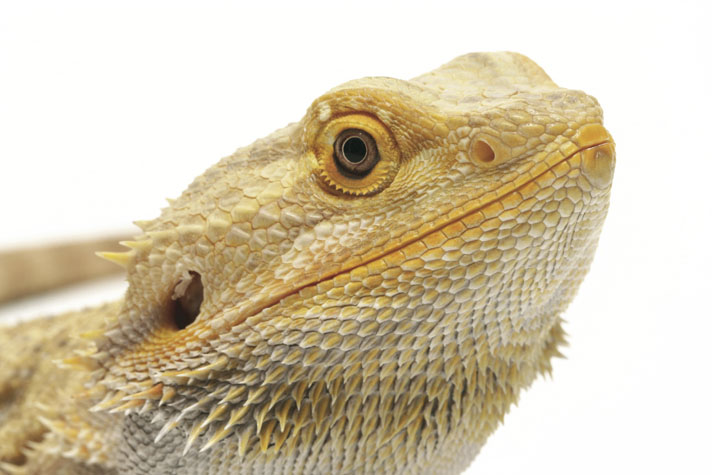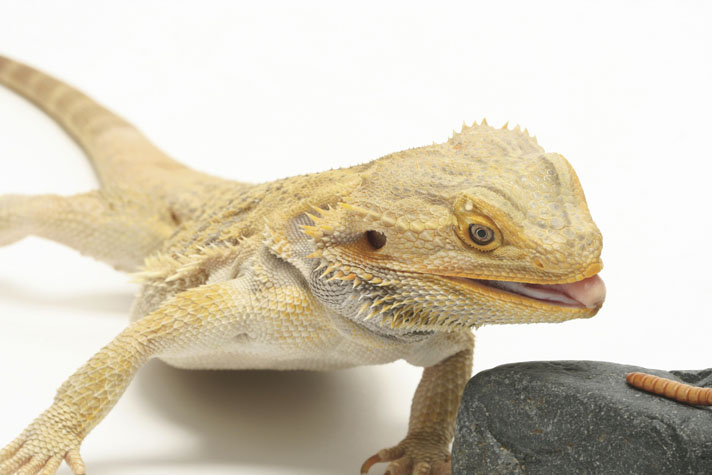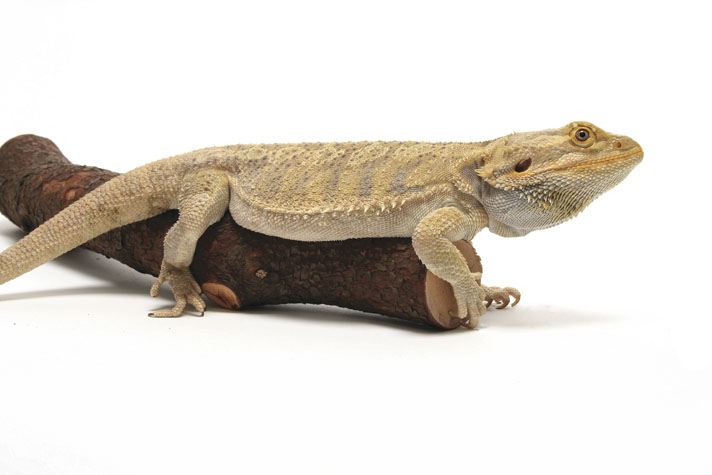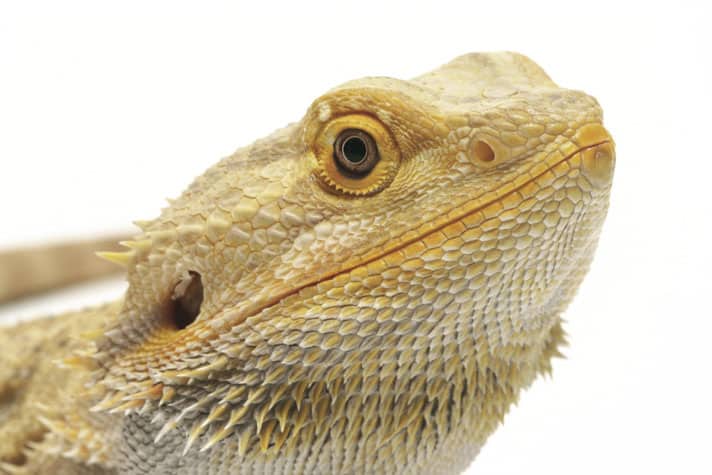The secrets to bearded dragon health and longevity.
Bearded dragons (Pogona vitticeps) have exploded in popularity since they were first introduced to North America a few decades ago. Their hardiness, long life span and mellow temperament make them a great choice for anyone interested in owning a pet reptile. But part of responsible ownership is making sure that you meet your pet’s specific needs. This means providing an appropriate habitat and the right nutrition.

gina cioli
Bearded dragons are not difficult to feed, as these popular lizards are very hardy eaters that enjoy devouring a wide variety of food items.
Over time, proper diet and nutrition will not only make your beardie healthier but can also help increase its life span, activity level and help keep its coloring more vibrant. Given that bearded dragons need a combination of vegetables and live food to stay healthy, their dietary requirements can seem complicated and overwhelming to anyone inexperienced with reptiles, but the tips in this article will help ensure that your beardie gets the right stuff.
Age Matters
Your bearded dragon’s age plays a large role in its diet and nutrition needs. A young beardie’s diet will consist of mostly insects so as to provide the protein and fats required to grow, whereas a mature bearded dragon requires a diet of mostly vegetables for overall health and nutrition.
Given that younger bearded dragons are constantly growing and protein is required to aid in that growth, they will have a large appetite for insects. Expect to feed younger dragons as many insects as they can eat in a 15-minute period, two to three times per day. Although younger dragons are constantly hungry, some owners have difficulty getting them to eat greens; however, it’s important to make sure their diet consists of 70 to 80 percent insects and 20 to 30 percent greens.
Your bearded dragon’s appetite will change as it reaches adulthood. Some will start eating more vegetables before 6 months of age, others will take longer. Keep fresh vegetables, plants and fruits in the tank throughout the day. As the dragon gets older, it will gradually begin eating more of the vegetables. There are some circumstances where fully grown bearded dragons will not eat vegetables, but normally, it is because they have been fed too many insects, keeping them full, and/or they are being fed veggies they don’t like.
Once they become adults, you will notice that they will not be as hungry as they were when they were rapidly growing, and their eating preferences will switch to 80 percent greens and 20 percent insects. To compensate for this dietary change, feed adults insects once every one to two days and maintain a fresh supply of fruits, plants and vegetables in the cage for them to eat throughout the day.
Available Insects

gina cioli
Bearded dragons will devour just about any insect that crawls in front of them.
Insects are an important part of a bearded dragon’s diet (especially younger dragons), so it’s necessary to make sure your bearded dragon is eating the right amount, type and species to stay healthy.
Favorite Insects
- Black soldier fly larvae
- Butterworms
- Cockroaches
- Crickets
- Dubia roaches
- Earthworms
- Locusts
- Redworms
- Superworms
First off, bearded dragons will devour just about any insect that crawls in front of them. However, not all bugs are healthy for bearded dragons to eat. It is up to you to make sure they are eating safe insects. As far as tasty insects go, you can’t go wrong with black soldier fly larvae, butterworms, cockroaches, crickets, Dubia roaches, earthworms, locusts, redworms and superworms. These insects are safe for bearded dragons and are relatively easy to get.
Insects To Avoid
- Fireflys
- Elderbugs
- Venomous insects, such as bees, wasps and scorpions
- Any insects that glow
- Insects you found outside
- Insects sold as bait for fishing
- Insects found inside your home
When feeding, let your beardie eat as many bugs as possible within a 15-minute period. After that time has passed, collect the remaining uneaten bugs and save them for another feeding. If you leave the insects in your bearded dragon’s tank for longer periods of time, you risk your bearded dragon overeating or the insects burrowing and hiding in the enclosure.
Make sure you get your bearded dragon’s insects from a feeder insect supplier. Never feed your lizard bugs you find outside or on your property, or insects intended to be used for fishing bait. This is because it’s not uncommon for the bugs around your house to have parasites or to have trace amounts of pesticides, both of which are dangerous for bearded dragons. You can purchase safe insects from local pet stores or from feeder insect suppliers online.
Feeding Veggies To Your Bearded Dragon
Plants, fruits and vegetables are an important staple of any bearded dragon’s diet. Ingesting these is how many bearded dragons get water as well as essential vitamins and minerals.
Anything frozen can lose its nutrition fairly easily, so it’s important to use fresh vegetables and greens. Bearded dragons will eat most greens and veggies raw, but if the vegetables are too hard, you may want to consider cooking them so they’re soft enough for your beardie to eat (just be sure the food is room temperature before offer it to your beardie).
There are numerous plants, fruits and vegetables that are safe and healthy for bearded dragons to eat, but some favorites include squash, collard greens, bell peppers, mustard greens and seedless watermelon. Of course, it’s best to mix up your bearded dragon’s diet every once in a while. Sometimes, adding variety can increase your lizard’s appetite.
Bearded Dragon Safety Concerns
Bearded dragons are not difficult to feed, as these popular lizards are very hardy eaters that enjoy devouring a wide variety of food items. The following tips should help make feeding your beardie easier and safer.

gina cioli
Bearded dragons live in very hot and dry climates, so they have adapted to survive on very little water.
- When eating plants and insects, beardies can accidentally ingest small bits of sand, gravel or other loose substrate with their food. Accidental substrate ingestion can put more stress on a bearded dragon’s digestive system and can sometimes lead to serious health concerns. Fortunately, this issue is more common in younger bearded dragons, as adults are more skilled eaters and can usually cope with minor substrate ingestion easier than younger beardies. Regardless of your bearded dragon’s age, digesting unwanted material is unhealthy, so it is not recommended to feed your bearded dragon on sand, pebbles or any other substrate that is loose or sharp. Many owners avoid this issue by using feeding bowls, hand feeding or by feeding their bearded dragons on substrates such as reptile carpet or butcher’s paper.
- Monitor the size of the food you feed your pet. Do not feed your bearded dragon anything that is wider than the space between its eyes. Anything wider than this space can cause impaction and/or put pressure on the spine, which can cause health and mobility issues, so be sure insects are not larger than this, and cut any fruits and vegetables you offer your beardie to the appropriate size.
- While not a major issue, overfeeding can cause obesity and should be avoided for health concerns. Most cases of overfeeding result from owners giving adult beardies insects that are higher in fat (such as waxworms) too often. It is recommended that you feed adult bearded dragons lower-fat insects, such as crickets, for meals, and offer fatty waxworms for occasional snacks or treats only, not as standard fare.
Hydration For Your Bearded Dragon
Bearded dragons live in very hot and dry climates, so they have adapted to survive on very little water. However, hydration is still an important issue. Your bearded dragon will receive most of its water from plants and vegetables. However, given that your bearded dragon’s tank is hot and dry, it doesn’t take long for the greens to become dehydrated, so sometimes it’s necessary to supply other water sources.
Some keepers put water dishes in their bearded dragon’s enclosure; however, bearded dragons come from desert environments and don’t recognize standing water very easily. In fact, they may not drink from their water bowl. Because of this, it is often more common for your bearded dragon to soak in its water bowl instead of drinking from it. Soaking is normal behavior for beardies and it helps with the digestion process. Given that bearded dragons often urinate or defecate while they soak, make sure to change the water regularly, and most certainly the moment you see it has been fouled.
You can also mist your bearded dragons to keep them hydrated. Misting with fresh water once or twice a day with a spray bottle simulates rainfall and dew. In nature, bearded dragons will drink the dew drops for hydration, so misting will recreate this environment. You can also mist your bearded dragons when they begin to shed. Hydration will help moisturize their skin and help them have an easier time shedding.
Soaking your bearded dragon while you supervise is not a bad idea, either. Frequent baths, about three or more times a week, will help with hydration. If your bearded dragon enjoys baths and doesn’t get stressed out, you can bathe it more frequently. Most beardies will drink the water while they’re bathing, so it’s important to make sure the bath water is fresh. If you decide to bathe your bearded dragon in a sink or tub, clean it thoroughly afterward because bearded dragons, like others animals, can carry Salmonella. Clean the sink before placing your bearded dragon inside it, as well. You do not want any soap residue to get on your pet. You are only soaking your dragon; you’re not actually “washing” your pet.
Important Vitamins And Minerals For Your Bearded Dragon
Understanding vitamin and mineral requirements can be a tricky task for many keepers, and making sure your beardie receives the right amount of supplements is vital to its health. To aid in understanding, this section will be broken down by vitamin.
Vitamin A And Bearded Dragons
Most adult bearded dragons will receive enough vitamin A from their vegetables, and younger bearded dragons generally receive enough vitamin A from the yolk within their egg to last them until they’re 6 months old (which is also about the time they start eating more greens). There are many vitamin A supplements available on the market that you can add to your dragon’s food, but only use those that contain beta carotene. Beta carotene is present in many vegetables, and when consumed, it is converted into vitamin A by the bearded dragon’s body. If a bearded dragon consumes too much beta carotene, its body simply excretes it instead of absorbing it, posing no risk of vitamin A overdosing. If you use a vitamin A supplement that contains artificial or synthetic vitamin A, your bearded dragon will absorb the vitamin A even if it isn’t needed, which can cause vitamin A toxicity.
Bearded Dragons, Calcium And Vitamin D3
Bearded dragons cannot absorb calcium without vitamin D3, so most supplements will contain both. Calcium and vitamin D3 are very important for development and growth. They promote healthy bones and help to prevent metabolic bone disease. Calcium and vitamin D3 are beneficial for gravid female dragons and also for young, growing beardies. Generally, baby bearded dragons will need a daily dose of calcium and vitamin D3, juveniles will need the supplement three to four times per week and adults only need it once per week.
Iron For Your Bearded Dragon
Iron is most important for babies because it helps with development. Usually, bearded dragons will receive enough iron from the vegetables they eat, but given that younger bearded dragons may not always eat their greens, it is necessary to provide a supplement. Younger bearded dragons generally receive enough iron from eating crickets. If a younger bearded dragon does need more iron, the options include feeding greens high in iron, getting an iron supplement from a herp vet or feeding a commercial food that contains iron.
Phosphorous For Bearded Dragons
Phosphorous helps with bone development. Fruits and vegetables are naturally high in phosphorous, so most bearded dragons will receive plenty of phosphorous from their diet. You should monitor your bearded dragon’s calcium-to-phosphorous levels to make sure they are receiving the right amount of both nutrients. If your bearded dragon’s diet is high in phosphorous, you will want to use multivitamins that are phosphorous-free. Too much phosphorous can prevent beardies from digesting calcium properly. The ideal level is 1.5±0.5 (Calcium):1(Phosphorous) or 1:1 to 2:1 Ca:P. The best way to watch these levels is to monitor your bearded dragon’s diet. Generally, the best approach would be to find a diet that your bearded dragon likes and stay with that diet. At that point, you can calculate the calcium ratios to see if a multivitamin is needed or if your bearded dragon’s diet needs to be adjusted.
Foods To Avoid Feeding Your Bearded Dragon
As mentioned previously, there are many insects and plants that you should avoid feeding your bearded dragon. While some of these items are simply unhealthy, others are poisonous and can be lethal if ingested.
Never feed your bearded dragon any insect that glows. This includes fireflies, lightning bugs or any worms that can glow in the dark. The chemical responsible for these insects’ glow is highly toxic to bearded dragons. Avocados should also be avoided because they’re also poisonous to beardies.
Non-poisonous foods that you should avoid feeding, because of their unhealthiness, include lettuce and spinach. Lettuce has no nutritional value and is mostly water, so avoid feeding your beardie anything with the word “lettuce” in the name. Spinach is healthy; however, it causes calcium to bind to it during the digestion process, which makes it more difficult for your bearded dragon to digest.
Final Thoughts
The bearded dragon’s temperament, long life span and general hardiness make it the perfect addition for any family. Whether you’re interested in getting your first bearded dragon or if you want to add another beardie to your family, these nutrition tips will help ensure your bearded dragon stays healthy for many years to come.
Steven Holdaway lives in Chattanooga, Tenn., and he is the founder and owner of thebeardeddragon.org, a popular website that teaches people about bearded dragon care, health and ownership.


